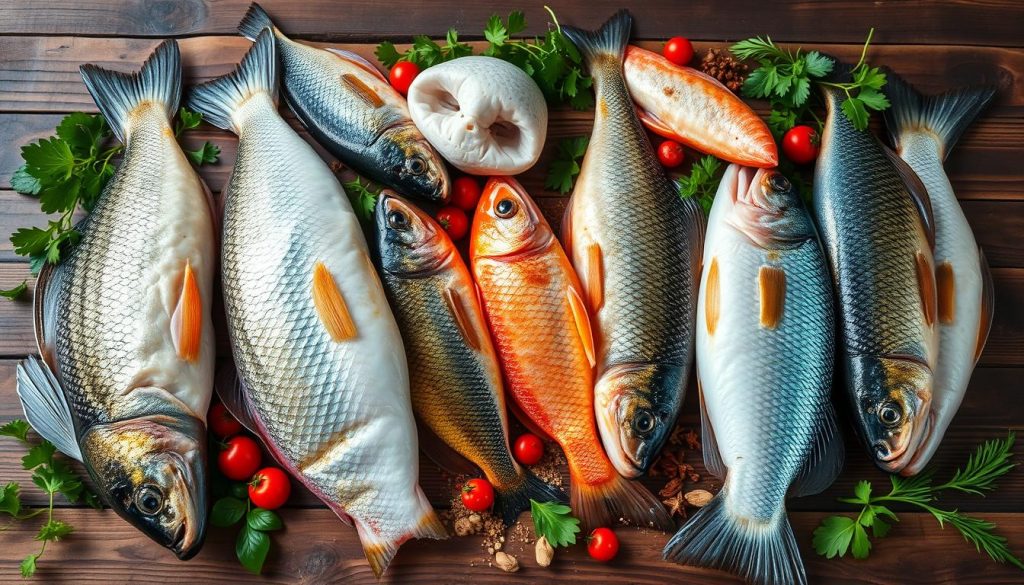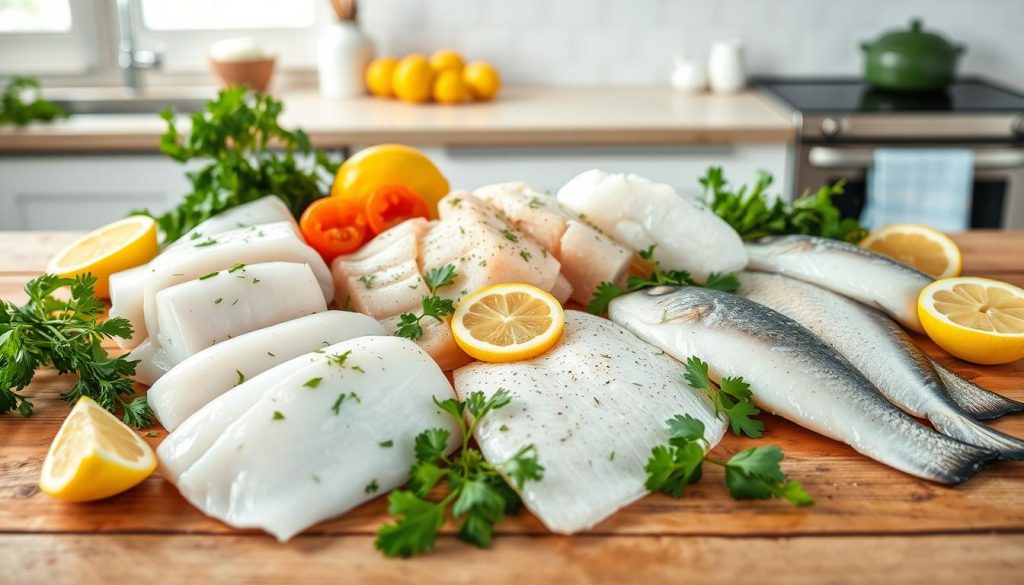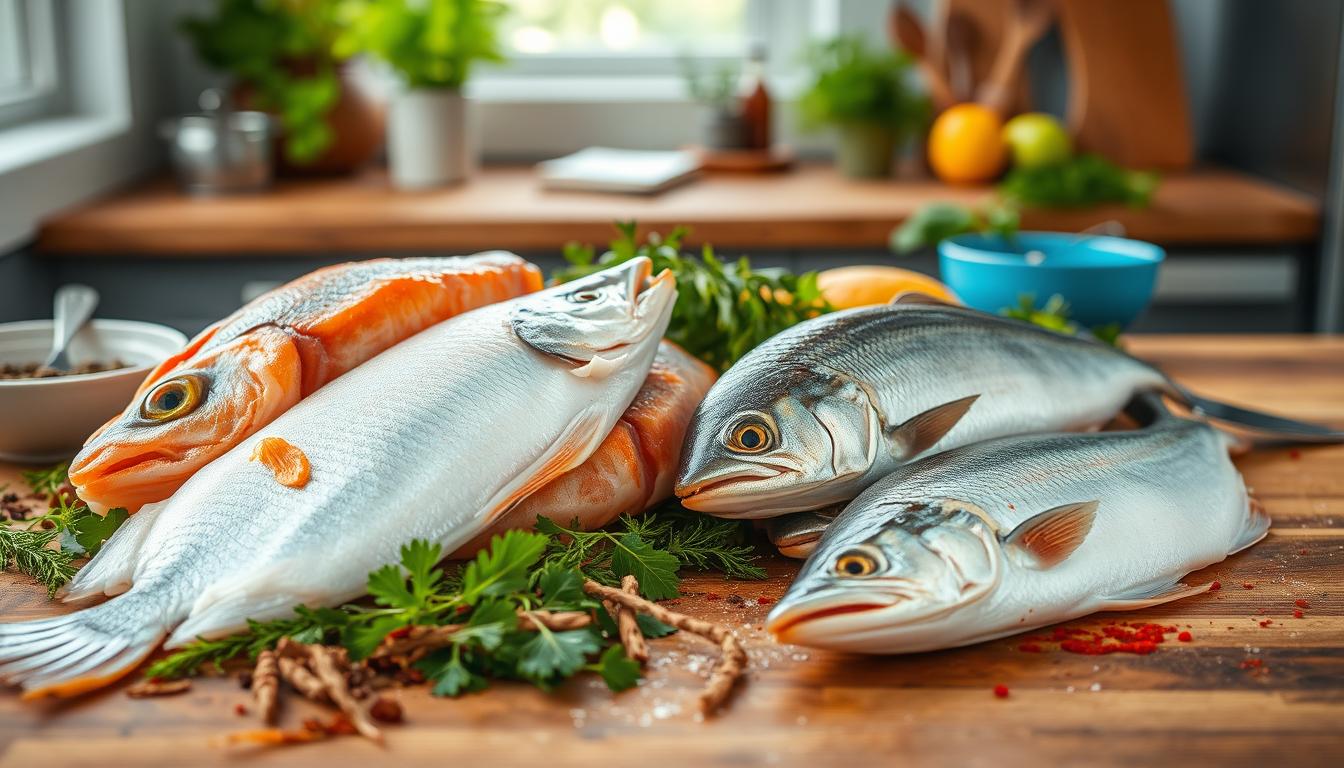Don’t worry if you can’t find catfish for your recipes. This guide will show you the best substitutes. You can still enjoy tasty seafood dishes. The American Heart Association says eating fish twice a week is good for your heart.
Catfish is loved for its taste and health benefits. It’s a lean protein with Vitamin D, riboflavin, and selenium. But, there are many other fish that can replace it in your cooking. This guide will help you pick the perfect substitute for your dishes.
Understanding the Need for Catfish Substitutes
There are many reasons to look for catfish substitutes. Sometimes, you might not find catfish at the store. Or, the price might change too much. If the catfish doesn’t seem fresh, it’s smart to find other options.
Your health goals or what you like to eat can also guide your choice. You might want fish that’s better for the planet or fits your diet better.
Why You Might Substitute Catfish in Your Recipes
Think about what you need for your cooking. Catfish alternatives give you more choices. You might want a fish that tastes better with your dish or cooks better.
Choosing sustainable seafood is also important. It’s good for your health and helps the planet. It supports fish populations and keeps ecosystems healthy.
Health Considerations When Choosing Fish
Choose fish that’s good for you. Look for lean protein and healthy fats. Fish with omega-3 fatty acids are especially good for your heart.
The American Heart Association says to eat fish twice a week. This can help lower blood pressure and reduce inflammation. Make sure the fish you pick is not only tasty but also full of vitamins like Vitamin D and selenium.
Benefits of Eating Fish
Exploring the benefits of eating fish shows why health experts recommend it. Fish is not just a protein source but also boosts heart health and overall wellness.
Nutritional Advantages of Consuming Seafood
Fish is a nutritional powerhouse, offering many health benefits. It’s packed with lean protein, vitamins, and minerals. Key nutrients include:
- Vitamin D
- Vitamin B2 (riboflavin)
- Selenium
- Omega-3 fatty acids, especially in fatty fish like salmon and mackerel
Eating fish regularly is backed by the American Heart Association. They recommend at least two servings a week. Studies show that 2 grams of omega-3 fatty acids a week can cut heart disease deaths by over a third.
Health-Related Benefits Linked with Fish Consumption
The health benefits of eating fish go beyond nutrition. Eating fish once or twice a week can lower the risk of serious health problems, such as:
- Heart disease
- Stroke
- Alzheimer’s disease
- Depression
- Diabetes
Fish is great for pregnant women, nursing mothers, and young children. The nutritional benefits of fish support brain development. This positively impacts a child’s intelligence and behavior.
Despite the seafood health benefits, only a small percentage of Americans eat enough fish. Adding fish to your meals can lead to immediate and long-term health benefits.
Catfish Substitute Guide
Choosing the right substitute for catfish is key to keeping your recipe just right. There are many options, like Pacific Halibut, Alaskan Pollock, Haddock, and Pacific Cod. Each has its own taste and texture, making them great for different dishes.
Top Substitutes for Catfish
- Tilapia: It’s easy to use as a 1:1 substitute, with a mild flavor that goes well in many dishes.
- Pacific Cod: It has a mild taste and firm texture, making it a versatile choice for many recipes.
- Pacific Halibut: This fish has a sweeter flavor and can be used in a 1:1 ratio, but it’s a bit pricier.
- Haddock: A good choice for fried dishes because of its delicate texture and mild flavor.
- Alaskan Pollock: A budget-friendly option with a mild taste, perfect for a wide range of dishes.
- Striped Bass: It has a firm texture and a subtly sweet taste, but it’s more expensive.
- Flounder: This fish has a mild flavor and a tender texture, but it’s pricier.
How to Choose the Right Substitute Based on Your Recipe
When picking a fish substitute, think about your recipe. For grilled, fried, or baked dishes, choose firm-textured fish. Mild fish works well when sauces or spices are the main flavor. For flaky textures, Rainbow Trout or Flounder are good choices. Always consider your recipe’s cooking method and flavor for the best results.

| Substitute | Flavor Profile | Texture | Cost |
|---|---|---|---|
| Tilapia | Mild | Firm | Budget-friendly |
| Pacific Cod | Mild | Firm | Moderate |
| Pacific Halibut | Slightly sweet | Firm | Higher |
| Haddock | Mild | Delicate | Moderate |
| Alaskan Pollock | Mild | Firm | Budget-friendly |
| Striped Bass | Slightly sweet | Firm | Higher |
| Flounder | Mild | Delicate | Higher |
Popular Types of Fish Alternatives
Exploring fish alternatives can add variety to your cooking. You can choose from white, lean fish to oil-rich ones. These options are not only versatile but also meet your nutritional needs.
White, Lean, and Firm Fish Choices
White fish alternatives are known for their mild taste and firm texture. They’re perfect for grilling, baking, or pan-searing. Here are some healthy seafood options:
- Pacific Cod
- Haddock
- Striped Bass
These firm fish are lean and great at soaking up flavors. They’re a healthy choice for those who want light but filling meals.
Medium-Colored and Oil-Rich Fish Options
For a burst of flavor, try medium-colored seafood like Wild Salmon, Mahi Mahi, and Yellowfin Tuna. These fish are packed with omega-3 fatty acids. They’re hearty and taste amazing with bold seasonings.
| Fish Type | Texture | Cooking Method | Nutritional Benefits |
|---|---|---|---|
| Pacific Cod | Firm | Bake, Grill | Lean protein, low in fat |
| Haddock | Flaky | Poach, Steam | Rich in Vitamin B2 |
| Wild Salmon | Medium | Grill, Roast | High in omega-3 fatty acids |
| Mahi Mahi | Firm | Sauté, Grill | Good source of selenium |
| Yellowfin Tuna | Steak-like | Grill, Sear | High in protein |

Conclusion
The search for good catfish substitutes is growing. This is because of things like how easy they are to find, their price, and how healthy they are. The guide we shared shows how important it is to try different fish in your cooking.
By trying out different fish, you can make your meals better and healthier. This way, you can still enjoy tasty seafood without using catfish. Fish like Pangasius, which comes from places like Vietnam, can be a great choice. They taste good and are good for you.
Choosing different fish can make you a better cook and follow the latest food trends. Whether you pick lean fish or something richer, it’s all about enjoying the taste and health benefits. This makes your meals both healthy and fun.
Source Links
- https://www.thescramble.com/everyday-environmental/fish-substitutions-when-you-cant-fish-your-wish/?srsltid=AfmBOor-EPnv4b_I83On6GDs8wrvNHlflfEW-WSOO54nVkEr9jeMCkAW
- https://www.in-fisherman.com/editorial/top-10-catfish-recipes/155591
- https://www.thescramble.com/everyday-environmental/fish-substitutions-when-you-cant-fish-your-wish/?srsltid=AfmBOooe5Kqh43etFqU1vdKc0HufTGqWJ5k77FzMDrEdbaTF-NZy6vIN
- https://thekitchencommunity.org/catfish-substitutes/
- https://nutritionsource.hsph.harvard.edu/fish/
- https://www.eatingwell.com/article/69763/5-of-the-healthiest-fish-to-eat-and-5-to-avoid/
- https://cookscrafter.com/catfish-substitutes/
- https://www.thescramble.com/everyday-environmental/fish-substitutions-when-you-cant-fish-your-wish/?srsltid=AfmBOopzLsGlI240kDDQl3WJzsWKdcn-FFBI9DMZmWewF0zrzv_0zt7B
- https://www.thescramble.com/everyday-environmental/fish-substitutions-when-you-cant-fish-your-wish/?srsltid=AfmBOoqjh24iznTKo7aozeArhN5YmnT4JE6wgQEhhhKPImfpg1bCyFRT
- https://thecookful.com/kinds-of-white-fish/
- https://www.medicalnewstoday.com/articles/fish-substitute
- https://digitalcommons.chapman.edu/cgi/viewcontent.cgi?article=1028&context=food_science_articles
- https://catfishfarmenterprise.com/alternative-feeds-for-catfish/
- https://www.ouraquariumlife.com/fish/otocinclus-catfish/
